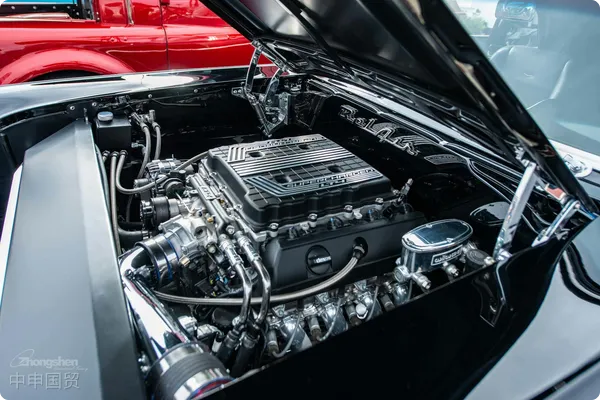- Shanghai Zhongshen International Trade Co., Ltd. - Two decades of trade agency expertise.
- Service Hotline: 139 1787 2118

In the process of globalization in the automotive industry, high-precisionAutomotive partsThe demand for imports continues to grow, with the camshaft position sensor (Camshaft Position Sensor) being a core component of the engine control system, and its...Import RepresentationThe service is of great significance in ensuring the supply of the automotive repair market and meeting the demand for high-end vehicle parts. This paper is based on 20 yearsforeign tradeExperience in agency services, systematically analyzing the key aspects of camshaft position sensor import agency from the perspectives of industry pain points, service advantages, and risk management.
Contents
ToggleII. Core Difficulties in Import Agency and Coping Strategies
1.The technical threshold is high, and the market relies on imports.
The camshaft position sensor must match the precise signal transmission of the engine ECU, with low technical parameter tolerance (typically less than ±0.5°). Currently, original equipment parts for high-end models (such as Mercedes-Benz, BMW, Porsche, etc.) are still primarily manufactured in Germany, Japan, and the United States. In the domestic market, the demand for imported original parts and OEM-certified replacement parts accounts for over 65% of the total.
2.The Value of Agency Services Amid Supply Chain Fluctuations
Affected byInternational LogisticsRising costs, geopolitical factors, and other influences have led small and medium-sized auto parts suppliers to face three major challenges in independent imports:
- Certification Barriers: Must comply with international standard certifications such as ISO/TS 16949 and ECE R10;
- Customs clearance complexity: Disputes over HS code classification of automotive parts (such as the tariff difference between 8542.31 and 9032.89);
- Quality control risks: There is a circulation of refurbished and counterfeit parts in the market, necessitating the establishment of a traceability mechanism.
II. Core Competitiveness of Professional Agency Services
1.Integration of global supply chain resources
- Direct procurement channel from the original manufacturer: Established long-term cooperation with Tier 1 suppliers such as Bosch (Germany), Denso (Japan), and Delphi (USA), providing genuine products with original packaging and batch traceability guarantees;
- Alternative parts development capability: For discontinued vehicle model parts, compatible products meeting the SAE J2718 standard are matched through secondary supply chains such as Turkey and Eastern Europe.
2.Compliance-based Customs Clearance Solution
- Accurate classification prediction: Confirm the HS code based on the sensor's technical parameters (magnetoresistive/Hall effect) to avoid the risk of port delays caused by classification errors;
- Apply for preferential treatment under the CIS Free Trade Agreement (tariff reduced from 12% to 6.5%): Utilizing RCEP agreement tariff rates and ASEANIt is recommended to verify through the following methods:Utilize policy tools such as tariff reductions to lower import costs (Example: Tariffs on sensors manufactured in Malaysia decreased from 8% to 5%);
- Fast - track customs clearance channel: Pre-declaration + electronic label verification mode reduces customs clearance time by 40%.
3.a whole - process risk management system
- Triple Verification Mechanism for Quality:
? Before leaving the factory: Third-party organizations (such as SGS) conduct tests on signal frequency (1-5kHz) and operating temperature (-40℃~150℃);
? After arrival: Laboratory-grade impedance testing (standard value 800-1500Ω);
? After-sales traceability: Laser anti-counterfeiting codes + blockchain notarization technology to prevent cross-regional sales. - Supply chain contingency plans: Establish dual backup warehouses in Europe and North America to mitigate the risk of sudden supply disruptions.
III. Detailed Practical Process of Import Agency (Taking EU Imports as an Example)
1.Demand confirmation stage
- Technical parameter verification: Match the model year and engine type (e.g., for BMW N55B30, the Bosch 0261530024 model must be used);
- Trade Term Selection: Under CIF terms, suppliers are required to provide IECEx explosion-proof certification (for diesel vehicle models).
2.Logistics and Customs Clearance Execution
- Packing Specification: Anti-static packaging + humidity indicator card, avoidMaritime TransportationDampened during transit;
- Document Management: Ensure the completeness and compliance of EU Certificate of Origin, ECE certification documents, and material declarations (RoHS 2.0).
3.Domestic Delivery and After-Sales Service
- Bonded warehouse distribution: targetingCross-border E-commerceThe customer provides 1210 bonded pre-stocking services;
- Technical Support: Provide sensor installation torque specifications (typically 8-10N·m) and diagnostic trouble code guidelines (e.g., P0340/P0341).
IV. Industry Trends and Directions for Agency Service Upgrades
1.New energyMarket Opportunities in Transition
Hybrid vehicles (such as Toyota's THS system) still rely on camshaft sensors, with the global market size for this category projected to reach $4.76 billion by 2028 (a compound annual growth rate of 4.2%).
2.Deepening digital services
- Develop a cross-border traceability platform for accessories: Scan QR codes to check production batches and customs clearance records;
- Intelligent Early Warning System: Predicts fluctuations in demand for specific vehicle model parts based on historical data (e.g., peak maintenance periods for the Volkswagen EA888 engine).
Conclusion
The import agency for camshaft position sensors is far from a simple trade transaction; it requires specialized services that integrate technical expertise, compliance management, and risk control. Choosing an agency with full-chain service capabilities can help clients reduce overall costs by 15%-30% while increasing on-time delivery rates to over 98%. Against the backdrop of accelerating technological iterations in the automotive industry, only by deeply partnering with professional agency service providers can sustainable supply chain competitiveness be achieved.
Related Recommendations
? 2025. All Rights Reserved. Shanghai ICP No. 2023007705-2  PSB Record: Shanghai No.31011502009912
PSB Record: Shanghai No.31011502009912









